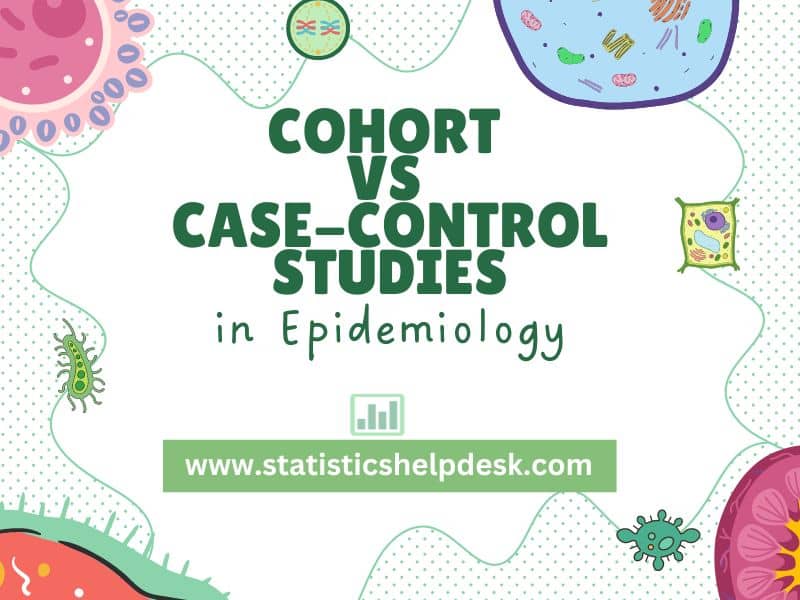Epidemiology is a significant field of study in public health as it helps in studying the causes and patterns of health or disease conditions in specified populations. Central to epidemiological research is the concept of study design, which forms the framework for performing systematic investigation into events related to health. Selecting the right form of study design is crucial since it determines the validity and reliability of the findings.

Epidemiological studies broadly fall into two categories: observational and experimental. Within the observational category there are two of the most common study designs, namely the cohort studies and the case-control studies. These study designs are invaluable in epidemiology to determine the relationships between exposures and outcomes as well as identify risk factors to carry out informed public health interventions.
It is important for the students studying epidemiology to be able to distinguish between cohorts and case-control studies. It is relevant not only in academic studies but also applicable in health studies. The subject of epidemiology is challenging because it is a synthesis of complex biological concepts, statistical analysis and critical thinking, which typically require that students are adept at intricate data interpretation and study design techniques. In this post, we will discuss the study design techniques and how epidemiology homework help service can simply these complexities through professional guidance and personalized support to enable students complete their coursework with confidence.
A cohort study is an example of an observational study design that involves studying a defined group of individuals over a period to determine the impact of certain exposures on outcomes. These studies are also prospective, which implies that they follow participants from exposure to the outcome over a period. Cohort studies can also be retrospective in which the present data is studied based on the past group to examine the outcome.
Case control is another type of observational study design that compares individuals with a particular condition (cases) to individuals without the condition (controls). This design is a retrospective one, since it involves exposure status assessment in both cases and controls in the past.
|
Feature |
Cohort Studies |
Case-Control Studies |
|
Study Design |
Follow a group forward in time to see how exposures affect outcomes.
|
Look backward in time to compare exposure levels between cases and controls. |
|
Directionality |
Prospective or retrospective |
Retrospective |
|
Timeframe |
Longer duration as it studies participants over time. |
Shorter duration as they use existing data or rely on participants’ memory. |
|
Efficiency |
Less efficient for rare outcomes |
More efficient for rare outcomes |
|
Cost |
More expensive and resource-intensive |
More cost-effective and quicker to conduct. |
Cohort Study Example
One of the most well-known examples of the prospective cohort study is the Framingham Heart Study. Started in 1948, it observed a group of people in Framingham, Massachusetts, to learn risk factors associated with heart diseases. For so many years this study has yielded a lot of information on the causes of heart disease and ways of how it can be prevented.
Case-Control Study Example
One recent case-control study was conducted to assess the relationship between mobile phones and brain cancer. Research was carried out to compare the usage of phone between the group of people that were diagnosed with brain cancer (cases) and the ones that did not (controls). This study design was selected since the occurrence of brain cancer was rare.
Epidemiology courses are usually demanding and involve a lot of epidemiological research assignments that demands mastery of both epidemiology and statistics. Epidemiological research has become highly data-driven. It is constantly evolving and progressing. It is the need of hour for students to learn advanced statistical methods to handle complex data and discover insights. Our epidemiology homework help service extends support to students who seek help to produce high quality analytical reports during their coursework.
Students in epidemiology frequently get assignments that involve:
Here are some strategies to approach epidemiological homework effectively:
1. Understand the Question: It is important to understand the research question, the type of study design, and the statistical tests that will be used before getting into the data.
2. Data Preparation: Preprocess the data to ensure accuracy and avoid issues such as missing values, cases of outliers and cases where the variables may have been coded wrongly.
3. Statistical Analysis: Choose the appropriate statical tests with respect to the data and research question. It is recommended to use R, SPSS, or SAS software to analyze the data.
4. Interpretation: Emphasize on interpreting the results in light of the research question of the study. Using statistical measures such as significance level, effect size and confidence intervals to derive logical and meaningful conclusions.
5. Visual Representation: Present the data and results using appropriate graphs, plots and charts to discover meaningful insights. It assists in explaining the results more precisely.
6. Critical Evaluation: Explain the findings, consider alternative explanations, and highlight the study’s limitations.
Our Epidemiology Homework Help service offers several features that make it the go-to resource for students:
It is important for students to have basic understanding of cohort and case-control studies. Both these study designs have their own advantages, disadvantages and relevance in different research scenarios. By learning these concepts, students can effectively design robust epidemiological studies and critically evaluate the results. We offer epidemiology assignment help to solve assignments involving complex statistical analysis in assessing factors influencing health outcomes. Whether you are a beginner or an advanced student, our services provides better learning experience and improved grades.
For students looking to deepen their understanding of epidemiological study designs, the following resources and textbooks are highly recommended:
Sign up for free and get instant discount of 12% on your first order
Coupon: SHD12FIRST